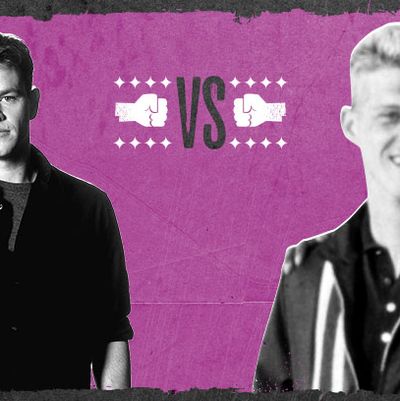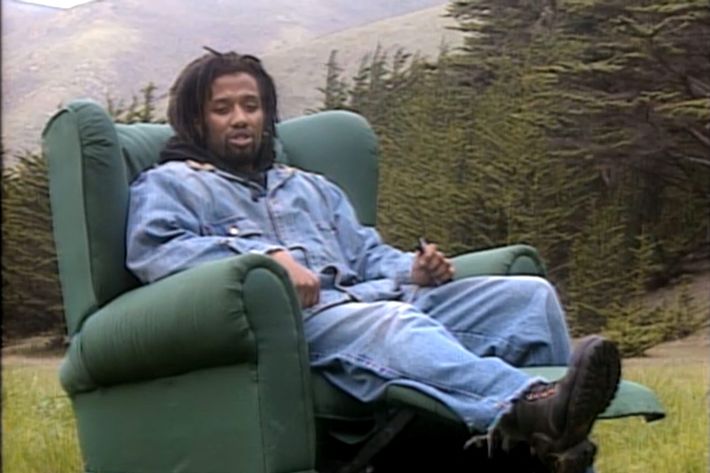Photo: Everrett Collection
Vulture is holding the ultimate Reality Rumble to determine the greatest season of the greatest reality-TV shows, from The Real World on. Each day, a different writer will be charged with determining the winner of a round of the bracket, until Vulture’s Margaret Lyons judges the finals on March 25. To kick off the bracket, Sarah Bunting pits The Real World’s iconic third, San Francisco season, with Puck and Pedro, against the second season of Ben Affleck and Matt Damon’s indie-filmmaking docu-series, Project Greenlight, which followed the making of The Battle of Shaker Heights, starring a young Shia LaBeouf.
At first, comparing The Real World to Project Greenlight seemed like an easy, lopsided call. Real World, now in season 29, is still on after 22 years, propelled by its simple premise: Throw a bunch of post-adolescent strangers together, give them booze and cameras to play to, and wait for the fights and sex. Project Greenlight barely made it through three seasons on two different networks with its loftier goal: give unknown writer-directors a shot at making a low-budget film, using the popular reality format to give the audience a glimpse of what independent filmmaking is really like. The show struggled for viewers even though it had star power: producers and occasional onscreen mentors Matt Damon and Ben Affleck, inspired to pay their own successes forward (or help struggling filmmakers skip some of the frustrations they’d faced, or both). RW is the pioneer; PG more of a footnote.
And it’s hard to argue with the bracket’s chosen third season of The Real World. RW’s San Francisco outing is one of those periods in television history that enters a conversation flanked by serious academic-study adjectives like “seminal” and “pioneering,” and it’s earned them. It’s not the first season of MTV’s seven strangers, picked to live in a house, et cetera — but especially compared with more recent Real World seasons that play like serialized bum fights, the sheen of earnest social engineering in RW’s Frisco season is almost visible onscreen, like a lens flare. (That could also be the cheap video stock; man, is early Real World ugly to look at, and that’s not even mentioning that busted recliner the producers made slam-poet Mohammed Bilal give so many interviews from, in a meadow next to …Brokeback Mountain? Where in Fog City was that located?)
The RW: SF cast is selected not for maximum conflict but for maximum contrast: the slobby anarchist bike messenger Puck thrown together with the HIV-positive activist Pedro; Pedro and African-American poet Mohammed in turn living alongside politically conservative Rachel, whose parents are horrified by her belly ring; sheltered, inquisitive Cory with the much more worldly med student Pam (and, later, the troubled Jo, Puck’s replacement, whom Cory accompanies to get a restraining order against Jo’s estranged husband). Today, we’d assume this melting pot was assembled to induce angry arguments; back then, it felt like the show hoped for compromise and education – that the cast would learn about, and from, one another.
PG is, at first glance, primarily notable as a celebrity time capsule: Ben Affleck is still with Jennifer Lopez, but it hasn’t become a capital-I Issue yet. Neither has the star of PG’s central film project, The Battle of Shaker Heights, one Shia LaBeouf, who plays Kelly, a teen who tries to use his war-reenactment hobby to defeat his high-school bête noir (while falling in love with an older woman). But there’s something more to Project Greenlight, and not just the preternaturally even keel of LaBeouf, only 16 but full of blunt insights (as when he tells one of his co-directors, Efram Potelle, that getting a set of notes from Potelle and the other co-director, Kyle Rankin, isn’t helping his process). Vehemently no longer famous now, LaBeouf wasn’t quite famous then, but he could really act. Rewatching his emotional scene with Kathleen Quinlan, in which Kelly sobs about his relationship with his father (William Sadler), had me wondering what the hell happened to the promising dude who seemed like a relative oasis of calm in the midst of the set’s low-budget chaos.
And PG also was serious about its mission to educate, to bring its “we’re losing the light” shorthand to a wider audience, showing how hard it is to make a film on “only” a million dollars, how many people it requires, what those people do. (The show may have found its writers and directors through an online talent search, but everyone else — casting directors, first assistant directors, and cinematographers — was a pro.) Though there was drama on the set (as there is even when professionals are directing a low-budget feature), there was also a non-pedantic tutorial on the importance or danger of trying to get the perfect shot, and the delicate psychology of the order in which producers send out offers to actors, locking up talent for key roles without offending possible fallbacks should an offer fall through.
The mix of drama and enlightenment is admirable, but Real World: San Francisco was immediately riveting. I’d forgotten how quickly it became evident that Puck was not entirely housebroken (he’s the last to arrive in the house, because he’s in city jail for outstanding DUI warrants), and how soon the ill-fated marriage between Puck’s snot-stained fingers and the communal jar of peanut butter was consummated (it’s the second episode). I’d forgotten too why Puck is so frustrating: it isn’t just a persona, the defiant allergy to manners, the talking about himself in the third person. It isn’t post-adolescent self-absorption, either, as its viewers were all young jackasses too. Puck reveals early in the season (and indirectly) that he had aggressively inattentive parents; this is his defense mechanism, this “let me alienate them on purpose before I do it by accident; that way, it won’t hurt” posture, and every wrong button getting pushed on both sides is hard to watch.
It’s hard to watch a lot of things from a reality show shot in 1994: the crazy-high waists on the jeans; Judd’s paisley suspenders and vague shapeless poof. This is what we straight ladies had to look forward to back then. And it’s still unexpectedly hard to watch Pedro Zamora, knowing not just how it ends, but how soon. Revisiting Pedro’s commitment ceremony to his partner Sean Sasser, the first such ceremony on American TV, I teared up a little, again; Sasser passed just last year, but Pedro, of course, died hours after the season finale aired in late ‘94. That’s how it was, twenty years ago, HIV a swift and certain death sentence: Pedro’s death brought it home, literally, for many people who had come to feel they knew him. While I giggled at the dated bits of the season — everyone has to share a landline; Pam’s succession of Seinfeld pirate shirts — the shadow of Pedro’s inevitable passing is always in the corner of the frame. The show actually was a force for good back then, personalizing AIDS for a generation of young viewers who for the most part could otherwise keep it out of their peripheral vision.
Project Greenlight was also edifying, albeit on a practical film-school level. But the reason season two is that show’s best is because of what the producers didn’t learn from their first go-round; the result is a compelling train wreck. The show tried to fix its mistakes, but compounded each one instead: like looking at how the project massively overwhelmed season one’s writer-director Pete Jones and deciding, okay, we’ll split the workload with a directing pair (well, trio, if you count Rankin’s unacceptable ponytail), and a separate screenwriter, Erica Beeney, who had the stereotypical writer’s difficulty letting go. The result: confused actors, long meetings, and days that went into overtime. And then there was the notorious Jeff Balis, the redheaded on-set producer fired in the first season by top dog Chris Moore (a producer on Damon and Affleck’s Good Will Hunting and the co-founder of their production company). Balis was brought back, despite flailing ineffectually in season one — though in his defense, working with a rookie director put Balis in tough spots, and the newness of the contest concept meant there was no precedent for him to follow. Did he just work cheap? Or was the opportunity to give Moore another chance to browbeat Balis too tempting to pass up? It’s the scapegoat equivalent of bringing back a superhero’s vanquished archnemesis. (Fun fact: Balis would go on to produce LaBeouf’s plagiarized short film, “Howard Cantour.com.”)
Battle of Shaker Heights’ co-directors Rankin and Potelle made Balis seem more competent by comparison. They don’t know what they’re doing — not saying anything during a casting meeting with actress Sharon Lawrence, or asking mulishly why they need a production designer — and they don’t know they don’t know what they’re doing. It’s classic “here comes the cliff” TV.
Producer Moore is good TV, too; he’s in charge when big cats Damon and Affleck are away, and while he believes in the project, he’s also responsible for staying on budget and soothing the project’s studio, Miramax. Moore learned something since the first season — to wit, no grade-school actors (both children cast in the previous season’s feature, Stolen Summer, uh … “struggled with naturalism,” you might say, and one endangered a climactic water scene when it came out that he’d lied about being able to swim). Moore also gleaned that it’s pointless to get volcanically angry about someone else’s baby when sarcastic resignation gets the job done just as well. Moore often trails off into speechless chuckles at yet another example of Rankin-Potelle intransigence, and it makes me want to sit down for a beer with the guy. When he notes that either they’re utterly clueless, or they’re “passive-aggressive, manipulative fucks,” Moore betrays a hint of admiration. He is, after all, a producer.
Project Greenlight is an idea whose time hadn’t quite come in the early ‘00s. Had it started after Project Runway, it might have had a better run, catching the wave of professional-process reality shows; a basic-cable network like Sundance could do well with a modified update of the concept (or at least with a weekend-afternoon rerun block), depending on the personnel involved. Real World’s time did come with the San Francisco season, which included flirtations among roommates (some lasting; Judd and Pam, who fell in love at Pedro’s bedside in 1994, are married with children) and more Caucasian cluelessness (Cory asks Mohammed’s girlfriend whether she’s half-white), in addition to making its cast members household names, for good (Pedro) or ill (Puck). PG never really put a filmmaker on the map — most of the names you remember from it, you knew before; even LaBeouf had a fine career in the making going in. And it also didn’t bring messages of tolerance and grace out into the world via a cast member’s illness, educational efforts, and passing.
So Project Greenlight puts up a dedicated fight: It’s a good idea, it’s aged well, and most of its conflicts often feel more organic than Real World’s. Yet the ultimate conflict, between Pedro and the scourge that defeated him, is in the end a more lasting legacy. PG is an overlooked gem, but it’s RW:SF that wears the crown here.
Winner: The Real World: San Francisco
Sarah D. Bunting is the East Coast editor at Previously.TV and a co-founder of Television Without Pity. She’s the one still watching American Idol.
Round 1: Real World: SF vs. Project Greenlight





